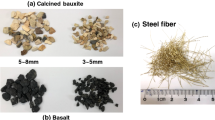Abstract
This research concerns the abrasion resistance of high workability concrete with various amounts of Supplementary Cementitious Materials (SCM). Various factors affect abrasion resistance, including the strength of concrete, water-binder ratio, amount of SCM, surface finishing, degree of aggregate exposure, and severity of the abrasive loading. An underwater abrasion test method, in which specimens are sectors of a circle, was newly proposed based on the modification from a typical method for simultaneous comparison of the abrasion resistance of concrete of differing mix proportions. Abraded concrete volumes were determined using a non-contact 3D measurement system. It was found that initial surface irregularities affect the development of ensuing erosion. Concrete containing more fly ash showed less abrasion erosion resistance at early age. Concrete mixed with blast-furnace slag showed higher abrasion resistance for approximately 20% replacement of cement, within the test range of 0∼60%. In addition, the abrasion resistance increases as the aggregate exposure ratio increases for concrete with fly ash.
Similar content being viewed by others
References
ACI Committee 210 (2003). Erosion of concrete in hydraulic structures (ACI 210R-03), ACI Manual of Concrete Practice, Part 1, American Concrete Institute, Farmington Hills, Mich.
Cooper, C. F., Liotta, F. J., and Shawl, E. T. (2005). “Optimization of polycarboxylates for use in self-consolidating concrete.” Proceedings of the Second North American Conference on the Design and Use of Self-Consolidating Concrete (SCC) and the Fourth International RILEM Symposium on Self-Compacting Concrete (Shah, S. P. (eds.), A Hanley Wood Publication, pp. 25–32.
Felekoglu, B., Turkel, S., and Altuntas, Y. (2007). “Effects of steel fiber reinforcement on surface wear resistance of self-compacting repair mortars.” Cement and Concrete Composites, Vol. 29, No. 5, pp. 391–396.
Hu, X. G., Momber, A. W., and Yin, Y. G. (2003). “Hydro-abrasive erosion of steel-fibre reinforced hydraulic concrete.” WEAR, Vol. 253, Nos. 7–8, pp. 848–854.
Imai, M., Ohhashi, T., Koide, Y., and Shimobayashi, S. (1987). “Characteristics of concrete containing blast-furnace slag.” Proceeding for the Symposium on the Application of Blast-furnace Slag Concrete, Japan Society of Civil Engineers.
Japan Society of Civil Engineers (JSCE) (1996). “Guideline for the construction practice of concrete containing blast-furnace slag.” Concrete Library 86, Japan Society of Civil Engineers, p. 89.
Kiliç, A., Atiş, C. D., Teymen, A., Karahan, O., Özcan, F., Bilim, C., and Özdemir, M. (2008). “The influence of aggregate type on the strength and abrasion resistance of high strength concrete.” Cement and Concrete Composites, Vol. 30, No. 4, pp. 290–296.
Liu, Y. W. (2007). “Improving the abrasion resistance of hydraulic-concrete containing surface crack by adding silica fume.” Construction and Building Materials, Vol. 21, No. 5, pp. 972–977.
Liu, T. C. and McDonald, J. E. (1981). “Abrasion-erosion resistance of fiber-reinforced concrete.” Cement, Concrete, and Aggregates, Vol. 3, No. 2, pp. 93–100.
Liu, Y. W., Yen, T., and Hsu, T. H. (2006). “Abrasion erosion of concrete by water-borne sand.” Cement and Concrete Research, Vol. 36, No. 10, pp. 1814–1820.
Mindess, S., Young, J. F., and Darwin, D. (2003). Concrete (2nd edition), Prentice-Hall, Englewood Cliffs.
Momber, A. W. (2000). “Short-time cavitation erosion of concrete.” WEAR, Vol. 241, No. 1, pp. 47–52.
Momber, A. W. (2004). “Aggregate liberation from concrete by flow cavitation.” Int. J. Miner. Process, Vol. 74, Nos. 1–4, pp. 177–187.
Naik, T. R., Singh, S. S., and Hossain, M. M. (1995). “Abrasion resistance of high-strength concrete made with class C fly ash.” ACI Materials Journal, Vol. 92, No. 6, pp. 649–659.
Ng, I. Y. T., Wong, H. H. C., and Kwan, A. K. H. (2006). “Passing ability and segregation stability of self-consolidating concrete with different aggregate proportions.” Magazine of Concrete Research, Vol. 58, No. 7, pp. 447–457.
Price, W. and Domone, P. (2007). “Exploitation of research into selfcompacting concrete.” Magazine of Concrete Research, Vol. 59, No. 8, pp. 543–545.
Schrader, E. K. (2003). Cavitation resistance of concrete structures, Frontiers in Hydraulic Engineering, American Society of Civil Engineers, New York.
Sebok, T. and Stranel, O. (2004). “Wear resistance of polymer-impregnated mortars and concrete.” Cement and Concrete Research, Vol. 34, No. 10, pp. 1853–1858.
Shi, Z. Q. and Chung, D. D. L. (1997). “Improving the abrasion resistance of mortar by adding latex and carbon fibers.” Cement and Concrete Research, Vol. 27, No. 8, pp. 1149–1153.
Siddique, R. (2004). “Performance characteristics of high-volume Class F fly ash concrete.” Cement and Concrete Research, Vol. 34, No. 3, pp. 487–493.
The American Society for Testing and Materials (ASTM) (1989a). ASTM C779-89a standard test method for abrasion resistance of horizontal concrete surfaces, ASTM.
The American Society for Testing and Materials (ASTM) (1989b). ASTM C1138-89 standard test method for abrasion resistance of concrete (underwater method), ASTM.
The American Society for Testing and Materials (ASTM) (1990). ASTM C418-90 standard test method for abrasion resistance of concrete by sandblasting, ASTM.
The American Society for Testing and Materials (ASTM) (1999). ASTM C944 test method for abrasion resistance of concrete or mortar surfaces by the rotating cutter method, ASTM.
Yen, T., Hsu, T., Liu, Y., and Chen, S. (2007). “Influence of class F fly ash on the abrasion-erosion resistance of high-strength concrete.” Construction and Building Materials, Vol. 21, No. 2, pp. 458–463.
Author information
Authors and Affiliations
Corresponding author
Rights and permissions
About this article
Cite this article
Choi, S., Bolander, J.E. A topology measurement method examining hydraulic abrasion of high workability concrete. KSCE J Civ Eng 16, 771–778 (2012). https://doi.org/10.1007/s12205-012-1135-2
Received:
Accepted:
Published:
Issue Date:
DOI: https://doi.org/10.1007/s12205-012-1135-2




